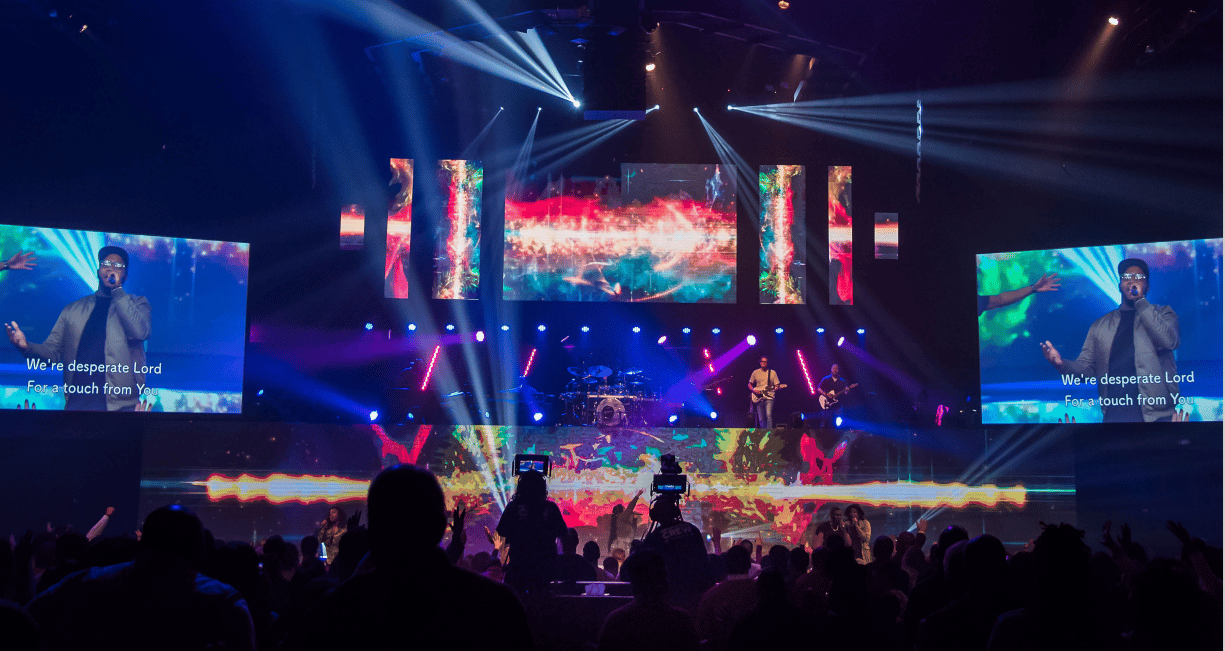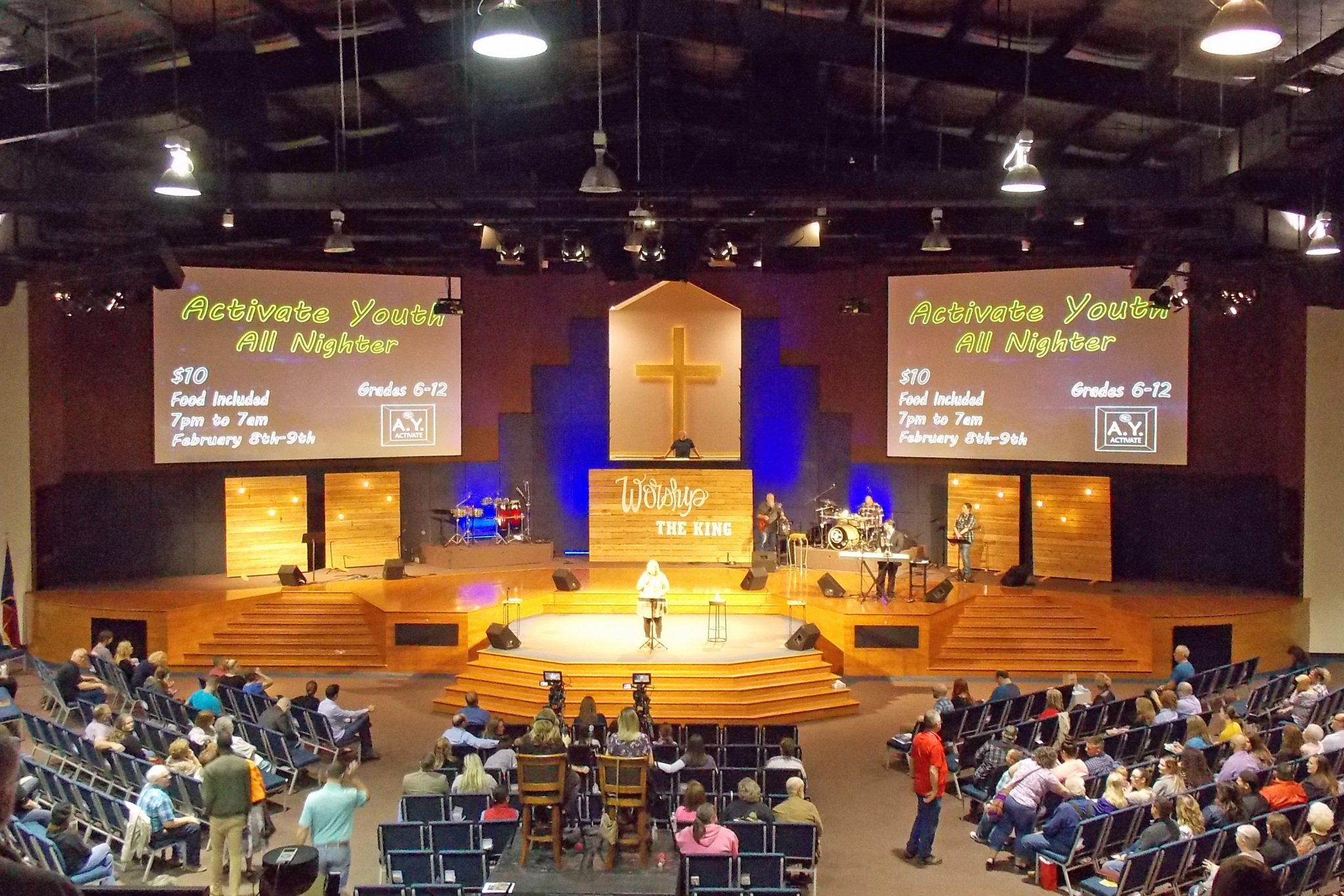Are you a church leader looking to enhance the worship experience?
Projection technology can help transform religious services, making them more enjoyable and interactive. Learn how projectors can be used to create a powerful connection with your congregation.
The use of technology in places of worship has become increasingly popular in recent years, with many churches making investments in audiovisual systems and equipment such as projectors to enhance the experience of their congregation. Using a projector can not only provide visual aids for presentations or teachings, but also can be used to create an immersive atmosphere through the use of special lighting and graphics.
In this guide we will discuss the different types of projectors available, as well as how to choose the right one for your church. We will also explain how to install and maintain your projector to ensure its optimal performance. Finally, we will look at some creative ways you can use technology in your church services that could really make a difference for your congregation.
Brief explanation of the importance of worship experience in churches
The worship experience is at the heart of the church’s mission. Churches create a spiritually meaningful environment for their congregants by providing services and prayers, incorporating ritual, fostering communal belonging and providing a space for education and spiritual growth.
The use of visuals is an important part of making this worship experience memorable, engaging and meaningful. Projectors are an effective tool to assist with the worship experience in churches by displaying Scripture verses, inspiring images or videos that enhance the message while simultaneously fueling emotion and engrossing the audience.
Projectors can add an extra level of excitement to a service that may not be attainable by other means. The size and impact of larger-than-life visuals on screens can pique your congregation’s interest and focus their attention more intensely on the weekly sermon points or messages from guest speakers.

Explanation of how projectors can enhance the worship experience in churches
Projectors offer a great way for churches to enhance their worship experience. By using a projector, it is possible to display images of religious artwork, hymns and scriptures on large screens, making it easier for members of the congregation to follow along.
Projectors can also be used in churches to create an immersive atmosphere by displaying video clips during church sermons. Videos can help illustrate the points being made and drive home the message of the sermon or Bible study. Additionally, projectors can be used to bring in virtual speakers or teachers during worship services or Bible studies, allowing congregations the opportunity to interact with a message from distant leaders without leaving the comfort of their own church.
Moreover, projectors can play an important role in youth programs by displaying entertaining movies which will engage young people and keep their attention during church activities. Multi-media presentations are also a great way for children and adolescents to learn about various religious topics as well as about scripture passages that might be difficult for them to understand otherwise. Additionally, multimedia presentations provide regular worshippers with a visual representation of topics that aren’t necessarily covered in traditional services.
Lastly, projectors are also helpful in church conferences/meetings where they may be needed as part of displays or presentations but can ensure members interact more effectively when discussing important matters regarding decisions on how best move forward with projects.
By utilizing projectors within churches, clergymen can expand upon their sermons while helping parishioners engage more actively with Bible stories and other teachings from scripture, allowing each member of the congregation to benefit from an enhanced spiritual experience that translates into everyday life outside of services at the place of worship.
Factors to Consider Before Buying a Projector for Church
When selecting a projector for your church, there are a number of factors to consider. Not only do you need to factor in budget, but also available space, power and projected image size. Here are some key features that should be taken into consideration:
Resolution: One of the most important factors when selecting a projector for your church is resolution or sharpness of the projected image. Projectors come in various resolutions including SVGA (800 x 600), XGA (1024 x 768) and Full HD (1920×1080). It’s important to note that higher resolution will mean better picture quality but also significantly higher cost.
Light Output: Light output is an important factor when determining the brightness of the projected image. A brighter image will ensure visibility even during daytime viewing, while lower light output may cause difficulty when viewing in areas with high levels of ambient light. Look for projectors with at least 3000 ANSI lumens for bright images in any lighting situation.
Luminance Uniformity & Color Accuracy: When it comes to color accuracy and uniformity, it’s important to look for projectors capable of displaying images with smooth tonality and color replication. Look for a minimum contrast ratio in the range 4000:1 – 5000;1 as this will provide generally excellent performance levels in both luminance uniformity and color accuracy.
Inputs & Connectivity: It is essential that your projector has compatible inputs enabling connection with all necessary equipment such as computers, mobile devices and/or audio systems necessary to enhance your church’s worship experience these days. A projector should have HDMI ports, VGA ports as well as audio-in ports among others. Additionally look to see if wireless compatibility is included as this can allow connection from mobile devices without the need for external cables.
Importance of brightness, resolution, contrast ratio, and throw distance
Projectors provide the ability to present dynamic visuals, making them attractive for churches looking to enhance their worship experience. However, in order to ensure a successful and effective projection setup, there are various factors that need to be considered. Brightness, resolution, contrast ratio and throw distance are all important factors to consider when selecting a projector.
Brightness: Projector brightness is measured in ANSI lumens and influences how visible an image will be on a screen. A higher lumen count equates to brighter projections (ideal for brightly lit environments) whereas lower lumen counts lend themselves better to low-light settings.
Resolution: Resolution determines the level of detail within an image or video file as well as its aspect ratio or shape (e.g., 16:9). Higher resolutions offer more detailed images and videos while lower resolutions tend to be adequate for displaying smaller text or PowerPoint presentations.
Contrast Ratio: This feature measures the range between the brightest whites and darkest blacks that a projector is capable of producing at any given time. While this feature doesn’t necessarily affect resolution levels, it should be taken into account when considering how realistic a projection will appear onscreen (i.e., if shadows appear too dark or whites too bright).
Throw Distance: Throw distance is measured in feet between an installed projector and the projection surface (usually a wall or screen). Selecting projectors with greater throw distances can eliminate having to reposition them during multi-use functions such as conferences versus worship services.
The size of the room and the number of people it can accommodate
When selecting a projector for church use, it is important to consider the size of your worship space. The number of attendees, together with the size of the room, will influence your choice. Smaller rooms may not require a projector with a large brightness; however, larger rooms will need a more powerful device to ensure that everyone can see the visuals clearly.
Additionally, consider using higher resolution in larger churches because projection screens and monitors may be too far away for lower resolutions. Also keep in mind that if you are projecting onto walls or ceilings directly without a projection screen, an ultra-short throw projector might be the best option because it allows for viewing from closer distances and reduces glare from lights.

Compatibility with existing equipment such as sound systems and screens
While implementing projectors can be a cost-effective and simple way to enhance your worship experience, it’s important to ensure that the equipment you purchase is compatible with your existing sound systems and screens. Many modern projector models come with wired audio outputs, allowing them to be easily connected to existing sound systems. Additionally, depending on the model of projector you select, some may feature touchscreens or USB ports which allow users to quickly connect laptops or tablets and begin streaming media or applications.
For churches that already have screens installed, it’s important to make sure that the projector model selected will fit properly within the available space and be compatible with existing mounting solutions. While most modern projectors are designed to work with standard ceiling mounting systems, it’s always wise to double-check prior to committing any money so that unexpected costs aren’t incurred later down the line.
Additionally, some churches may wish to take advantage of additional benefits such as remote control functionality – many modern projectors feature both wired (RS232) and/or wireless networking connectivity for quick and easy control from any device on-premises or remotely over an internet connection.
worship scenarios
Projectors are an ideal way to enhance church worship experiences. Whether used during services, Bible study classes, or other special events, projectors make it possible to share key images and video with a larger audience in high clarity. However, the type of projector that you choose depends on several factors. Here is a guide to selecting the right projector for your church’s worship scenarios:
Worship Services – In most cases, including during services, you will want a data projector with a high resolution and brightness of around 2000 lumens or higher. These projectors are ideal for displaying both still and moving images as part of sermons and speeches.
Bible Study/Educational Classes – For these types of scenarios, consider a conference room-style projector featuring an in-room digital camera for sending out visuals from around the classroom. This will allow your group to focus on the images displayed on screen when discussing verses or studying topics in more detail.
Special Events – For special events such as holiday celebrations and concerts, choose a short-throw projector with audio inputs. This type of projector is great for projecting onto walls or other surfaces from short distances so that everyone can see the images being shared from across the room. Furthermore, audio inputs provide better sound quality which can help enliven any service or celebration activity taking place.
These are just some ideas for selecting the right type of projector for your church’s worship scenarios based on what kind of events are taking place there each week. When determining which projector is best suited for your needs, it’s important to consider size requirements as well as available features like 3D support, image adjustments such as brightness & contrast ratios along with lens capabilities geared towards long range projection distances or short throw applications like detailed demonstrations at close range set-ups. Understanding all these factors will guarantee you get the best performance from your equipment while providing maximum impact to further elevate those surrounding experiences within your faith community!
Maintenance and Care of Projectors
Maintaining and caring for a projector is an essential step to ensure longevity of the equipment and a smooth experience during services. As projectors are expensive pieces of equipment, proper maintenance and cleaning can help to maximize performance while maintaining quality and prolonging the life of the device. To ensure your projector will last longer, it is important to follow good practices when using it.
Regularly clean the dust off of your lenses and other exposed surfaces with supplied lens wipes or a microfiber cloth. Make sure to use only specialized cleaners that are compatible with your specific projector model; using abrasive cleaning materials such as alcohol wipes may damage the lens coating, deteriorating image quality over time.
A good practice would be to power down your projector after use for proper heat dispersion; allowing dust and dirt particles to accumulate in or around air vents could lead to build-ups that could lead to all sorts of issues ranging from clogging/decreased ventilation effectiveness or even fire hazards. Always also be sure turn on your encasing lights when handling/making maintenance & adjustment procedures on any projector system.
The filters should be replaced at regular intervals, especially if you frequently display pictures with very bright colors or allow smoking in spaces where you’re using the projector – this helps prevent any smoke residue from clogging up and obscuring air vents or dampening internal parts due air humidity enhancing problems caused by prolonged exposure in such conditions.
Projector lamps have limited lifespans; these lamps should always be replaced every once in a while (check manual instructions before) as they provide much lower light output levels when they wear out & can sometimes malfunction during usage leading up unexpected service interruptions resulting in angry parishioners!
Explanation of how to properly maintain and care for projectors to ensure their longevity and optimal performance
In order to ensure optimal performance and longevity of projectors in worship spaces, it is important to properly maintain and care for them. This includes regular inspections and proper use, as well as methods of cleaning, storage and cooling.
Regularly Inspecting the Projectors: Projectors should be inspected each month for dust accumulation, visible fading of colors and clarity of images. Check air vents for dust build-up. If the projector is exhibiting any signs of overheating or not performing optimally, further inspection may be necessary by a qualified technician or authorized service provider. Projectors should also have their lamps changed every 5000 hours of use as this maintains a bright image – follow the instructions detailed in your manual for replacing a bulb safely. Additionally, you should check the tension of cables connecting the projector to ensure that any cables or connections are firmly secured and in good condition.
Proper Use: Never attempt to service a projector while it is powered on. It’s recommended that projectors are only painted when they are off; even low levels of heat could negatively affect its performance – so it is important not to subject it to extreme temperatures or humidity when painting backgrounds/words on screens behind them etc. Additionally, when setting up in new environments – movements such as setting up stages before plugging up your equipment can cause unwanted electric shocks if not done properly; exercise caution with moving around potential electric sources such as drums/mics etc while they’re setup and switched off from the wall sockets power supply.
Cleaning: Dust routinely accumulates inside areas such as lenses and optics which can lead to blurry projections; these parts require additional attention during cleaning procedures since small scratches can occur due to incorrect materials used bit this will risk further damage if left unchecked so please make sure only soft materials such as cotton swabs used for gentle scrubbing after using specialized solutions such as compressed air etc – Never apply liquid solutions directly onto sensitive parts The overall exterior should never be cleaned with water but instead with antistatic cleaners designed specifically for projectors (as designed by manufacturers); follow instructions carefully provided on these solutions! Again, these are very delicate components that you must handle with care!
Storage: Screen tenders must correctly store their projectors inside its protective case out at room temperature away from sunlight when not in use – violent temperatures could cause permanent damage over time due high humidity levels-this could lead technological malfunctioning over long-term misuse! Be aware also that packing any equipment too tight might mean certain parts get damaged due pressure applied onto them (as sometimes we assume machines fit tighter than they actually do); make sure there’s space left within containers/equipment bags where applicable with sufficient room temperature factors taken into consideration too-if unsure please refer website’s manufacturer general advice prior packing away anything potentially expensive or delicate (e .g) laptops…etc
Tips on troubleshooting common issues with projectors
Modern projection technology provides churches with excellent opportunities for enhanced worship experiences, but it is important to be aware of possible common issues that may arise over time. Fortunately, there are a variety of helpful tips and tricks for troubleshooting projectors in churches.
If the projection image looks blurry or distorted, check the tracking and focus settings to ensure they are properly adjusted. The projector should be fine-tuned to adjust each of these elements on an ongoing basis if the image distortion persists. Additionally, check all of the connection points and re-tighten any loose connections as needed. Poor connections are a common cause of distorted images.
If you hear a loud humming noise coming from your projector, this may indicate that its cooling fan needs to be cleaned or replaced due to excessive dust buildup inside the device. This requires dismantling the device to access its core components which is best done by an experienced technician who knows what to look for when performing repairs and maintenance on projectors in churches.
It’s also important to ensure that your projector bulb is properly maintained as well; replacing bulbs more than once a year can potentially cause more problems down the road if not done correctly. If you notice that one half of a projected image is darker than the other, this could indicate an issue with color balance or using outdated bulbs past their expected lifespan; replacing old bulbs with newer ones should resolve this issue accordingly.
Finally, some users find it helpful to relocate their projector devices slightly closer or further away from its screen surface depending on how clearly defined walls may be when viewed from different angles – as this will ensure images remain sharp instead of pixelated over long-term use. By taking these steps regularly throughout their use cycle, you should have no problem maintaining high quality visual displays in your church’s woship setting!

Conclusion
In conclusion, worship projectors can have a tremendous impact on the quality of a church service. By utilizing slides, videos and other digital outputs, churches have the power to create an immersive environment that engages audiences deeply and heightens the collective spiritual experience.
Choosing the right projector for your church is important for ensuring your needs are met and that you get the most out of your investment. Here we’ve reviewed all the aspects to consider when selecting a projector and implementing it into your church’s setup. We hope this guide help you make an informed decision when it comes to investing in projection technology for your house of worship.
FAQs
What is the purpose of a projector in a church?
The purpose of a projector in a church is to display lyrics, scripture, videos, and other multimedia content during services or events.
What is the best projector setup for church?
The best projector setup for a church depends on factors such as the size of the church, the lighting conditions, and the content being displayed. A professional AV installer can help determine the best setup.
What size projector screen for church viewing distance?
The size of the projector screen for church viewing distance depends on the size of the church and the seating arrangement. A general rule of thumb is to use a screen that is 1.5 to 2 times the width of the projection image.
How do I choose an auditorium projector?
When choosing an auditorium projector, consider factors such as the size of the room, the ambient lighting conditions, the resolution, and the brightness level required for the content being displayed.
How many lumens do I need for a small church projector?
For a small church projector, you will need at least 3000 lumens to ensure a bright and visible image.
What is the best distance for 100 projector screen?
The best distance for a 100-inch projector screen depends on the projector’s throw ratio and the room size. A general rule of thumb is to place the projector between 1.5 to 2 times the screen width away from the screen.
How can I make my projector work better?
You can make your projector work better by adjusting the brightness level, optimizing the color settings, cleaning the lens and filters, and using a high-quality projection screen.
What makes a projector better?
A better projector offers high brightness, contrast, resolution, color accuracy, and ease of use. It also has a long lifespan and a low cost of ownership.
How can I make my projector more powerful?
You cannot make your projector more powerful, but you can improve its performance by using a brighter bulb, optimizing the settings, and using a high-quality projection screen.
What are the five advantages of a projector?
The five advantages of a projector are large screen size, cost-effectiveness, portability, flexibility in placement, and immersive viewing experience.
See Also:
- Best projectors under $200
- Pocket projectors best buy
- Best projectors for business
- Best projectors for presentations
- Best projectors for churches

